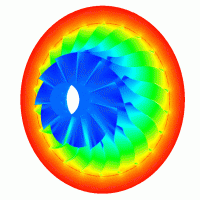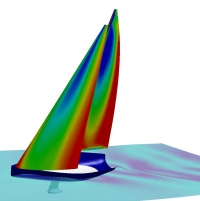You are here
About Us
 In 1985 the University of Florence started a research project on advanced aerodynamic design. The aim was to improve design by taking advantage of the most recent research tools as soon as they become available. A large part of this project was focused on Computational Fluid Dynamics (CFD) and carried out in conjunction with NASA Langley and Lewis Research Centers. The research activity lead to the development of CFD codes (TRAF and HYDRO) specifically tuned to assist turbomachinery designers in advanced aerodynamic applications. These codes are used worldwide by leading companies and research centers (i.e. NASA Lewis, Von Karman Institute, Fiat Avio, GE Nuovo Pignone, Ansaldo Energia).
In 1985 the University of Florence started a research project on advanced aerodynamic design. The aim was to improve design by taking advantage of the most recent research tools as soon as they become available. A large part of this project was focused on Computational Fluid Dynamics (CFD) and carried out in conjunction with NASA Langley and Lewis Research Centers. The research activity lead to the development of CFD codes (TRAF and HYDRO) specifically tuned to assist turbomachinery designers in advanced aerodynamic applications. These codes are used worldwide by leading companies and research centers (i.e. NASA Lewis, Von Karman Institute, Fiat Avio, GE Nuovo Pignone, Ansaldo Energia).
 In 1995 the University of Florence joined Marine Services in developing innovative appendages for racing yachts. During this project, to better meet racing yacht conditions, an innovative family of laminar airfoils (F65 type) was developed. These foils were used in the Vismara '40 Querida which won the Sardinia Cup in '96. Querida'sexperience shows how there are a number of techniques in aeronautical/aerospace aerodynamic design that can be equally useful when applied to a racing yacht.In 1998 the University of Florence, Vismara Design & Consulting, UK Sailmakers Italy, Hydea, and Tecnivela founded the International Consortium for Advanced Design (ICAD). ICAD is a non-profit organization whose goal is to promote exchange and interaction between industries, research centers, and academic institutions that carry out activities in the field of advanced aerodynamic design. Because of the non-profit nature of ICAD, the Consortium does not intend to compete with private companies. On the contrary, ICAD, based at the "Sergio Stecco" Department of Energy Engineering of the University of Florence, is intended to fund undergraduate theses, Ph.D. theses and Post-Doctoral programs on specific topics of relevant impact for practical applications.
In 1995 the University of Florence joined Marine Services in developing innovative appendages for racing yachts. During this project, to better meet racing yacht conditions, an innovative family of laminar airfoils (F65 type) was developed. These foils were used in the Vismara '40 Querida which won the Sardinia Cup in '96. Querida'sexperience shows how there are a number of techniques in aeronautical/aerospace aerodynamic design that can be equally useful when applied to a racing yacht.In 1998 the University of Florence, Vismara Design & Consulting, UK Sailmakers Italy, Hydea, and Tecnivela founded the International Consortium for Advanced Design (ICAD). ICAD is a non-profit organization whose goal is to promote exchange and interaction between industries, research centers, and academic institutions that carry out activities in the field of advanced aerodynamic design. Because of the non-profit nature of ICAD, the Consortium does not intend to compete with private companies. On the contrary, ICAD, based at the "Sergio Stecco" Department of Energy Engineering of the University of Florence, is intended to fund undergraduate theses, Ph.D. theses and Post-Doctoral programs on specific topics of relevant impact for practical applications.
Presently ICAD is carrying out research in the following areas:
- Gas-turbine-based aeronautical and land-based engines
- Compressors, fans and propellers
- Cryogenic rocket engines
- Innovative design of appendage and sails for racing yachts
- Three-dimensional viscous-based prediction of wave resistance.
